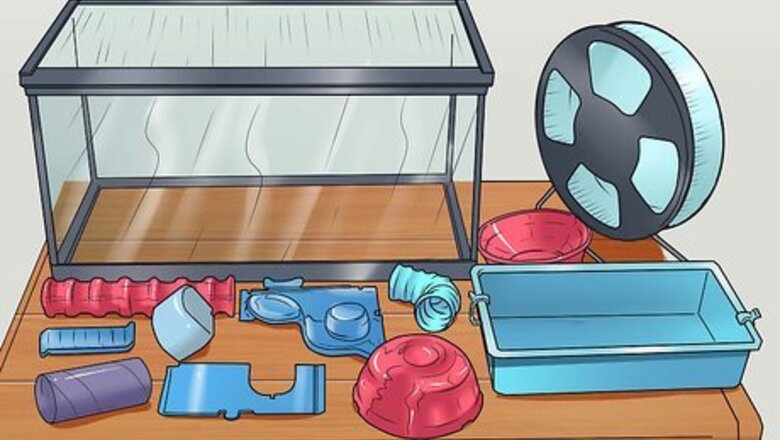
views
Getting Ready to Clean
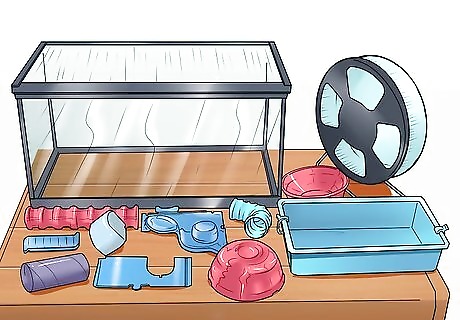
Examine the hamster's cage. Before you start to clean, you should take a look at the hamster's cage to see what state it is in. Look for anything that needs cleaning at least once everyday, even if it's not a scheduled cleaning day. Cleaning your hamster's cage too often or too little can cause them undue stress, so make sure you are cleaning the right amount when needed. Look for any droppings or wet areas in the bedding material. You can spot remove some areas. However, if there are a lot of them you should change the bedding. Pick out any leftover food that your hamster may have left laying around the cage. Change the water daily. If the bedding material has become soaked or damp near the water dispenser, you may want to change the bedding out. If the walls of the enclosure are looking dirty or smudged, it may be time for a full cleaning. If the cage smells you must clean it fully. Hamsters have a very sensitive sense of smell and can fall ill if the cage is unclean or the air quality is too poor.
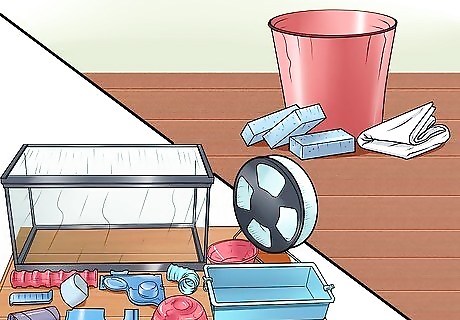
Gather your cleaning supplies. Before you get started cleaning, it is a good idea to assemble everything you will need. This can make the process much easier and less stressful for both you and your hamster. Collect the following items to get started: Wash cloth or baby wipes. This will be used for scrubbing and cleaning the cage and anything in it. Disinfectant. You can use mild, antibacterial hand or dish soap. Avoid harsh chemicals like bleach as these can harm your hamster. Pet stores will often carry safe and approved cleaning solutions as well. New bedding to place in the cage after you've cleaned it. Keep about a third of the bedding so they don't get stressed.
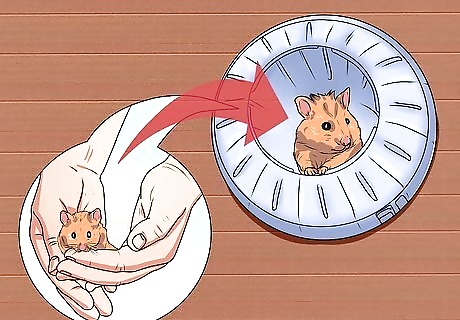
Remove your hamster. You won't be able to clean the cage properly unless you have removed your hamster from it. Place your hamster in a secondary cage or playpen. Handle your hamster gently as you remove them from the cage. Cup your hamster in your hands, fully supporting their entire body. Don't put your hamster in an exercise ball as they can be highly dangerous and is even considered to be cruel by some people. Wash your hands before and after handling your hamster to protect both of you from spreading germs and getting sick. You can use regular unscented hand soap for this.
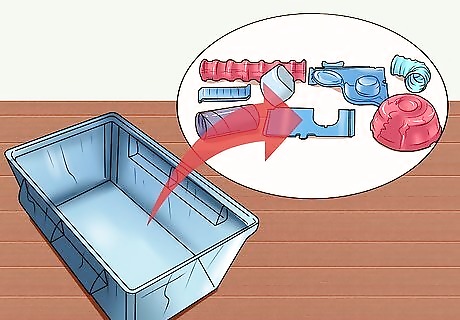
Take out all objects in the cage. After you have removed your hamster and have placed them in a secure environment, you will need to take out any objects in the cage. Leaving anything in the cage will make cleaning it more difficult and not as effective. Remove all food and water bowls or dispensers. Take out any toys or exercise equipment.
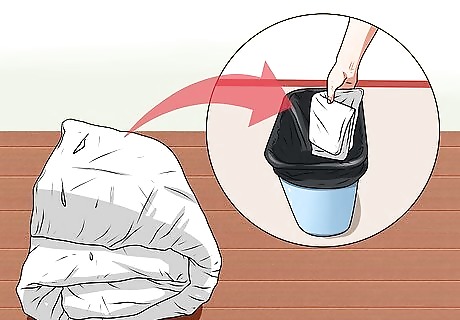
Discard old bedding. The last thing you need to remove from the cage will be the bedding. The bedding is where your hamster leaves its waste, resulting in what can be a strong ammonia scent which can cause respiratory problems for your hamster. Make sure to keep a little to mix in with the new bedding and reduce the hamster's stress. You may want to seal the old bedding in a waste bag of its own to lock in any smells.
Cleaning the Cage
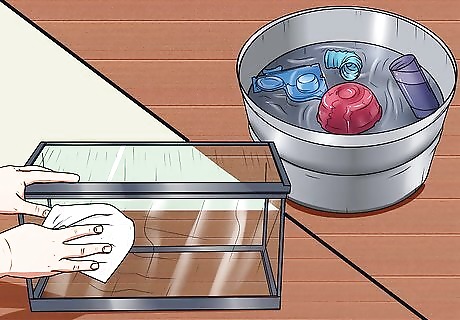
Wash every object that was in the cage. Although it may not appear dirty, you will want to clean every toy, exercise station, food and water bowls, and any other thing that is housed in your hamster's cage. Clean them thoroughly to ensure that your hamster's house is as fresh as it can be. Spray or soak cage items in your cleaning solution to disinfect them. Use your washcloth to clean the cage items as thoroughly as you can. Make sure to get all corners or any tough to reach spots.

Clean the cage itself. Cleaning the cage is the main focus of the regular maintenance of keeping your hamster's home tidy and hygienic. Make sure you clean every surface completely and thoroughly. Hamster cages may vary in their construction, however, the same general cleaning tips apply to all types of hamster cages. Use your disinfectant solution and cloth to scrub the cage clean. Some areas may have bedding stuck to the cage wall. These may need to be scraped away or scrubbed vigorously to remove. Soaking problem areas of the cage can help break them up and allow for easier removal. If your cage is a wire or mesh cage, make sure to clean each bar. Some cages are aquariums and these will require you to completely clean each surface and corner.
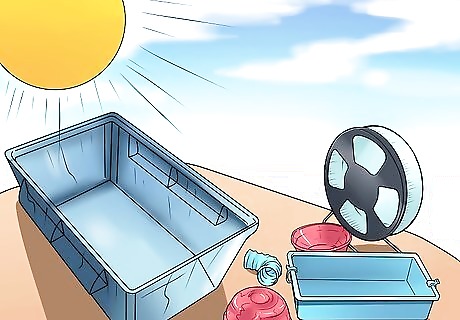
Dry the cage and anything that was in it. Before you can put the cage back together, you will need to let the cage dry. Adding new bedding before the cage is fully dry can cause the bedding to become wet, resulting in it needing to be cleaned again faster than normal. You can towel dry the cage and items if you want to hurry the process up. Leaving the cage in the sun can help it dry faster. Sunlight can also help to disinfect the cage, due to its UV light rays.
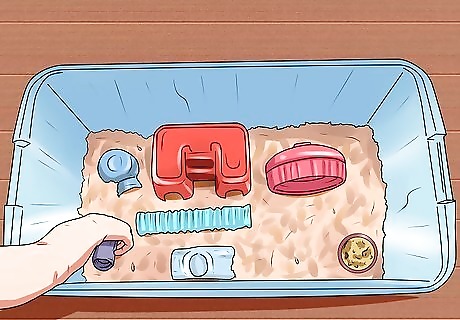
Put everything back together. Once everything has been disinfected, cleaned, and allowed time to dry you can reassemble your hamster's cage. Do a final check as you place items in the cage to make sure they are fully cleaned. Place fresh, clean bedding in the cage first. Put any toys or exercise equipment back in the cage, on top of the bedding. Add fresh food and water to your hamster's bowls or dispensers and place them back in the cage. Place your hamster back in the cage and allow it time to adjust and relax before interacting with it again. Try giving it a few hours to get used to the cage again before interacting with it.
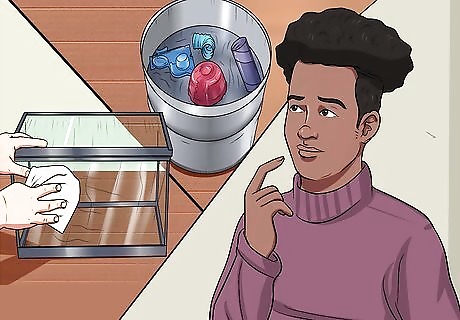
Schedule the next cleaning. Keeping up with the cleaning of your hamster's cage will make cleaning it easier and will help keep your hamster happy and healthy. After you clean the cage mark the date down and schedule the next cleaning exactly one week later. Regular cleaning of your hamster's cage is necessary. Clean the cage fully at least once a week. Marking down the cleaning schedule on a calendar can help serve as a reminder.

Keep up with daily cleaning. Once a week, you will want to fully clean your hamster's cage. However, this doesn't mean that you should clean only once a week. There are a few things you should do daily to help keep the cage as clean as can be in between more thorough cleanings. Remove any visible droppings. Remove, clean, and refill your hamster's water dispenser. Take out any fresh food that your hamster didn't eat. Add more bedding if needed.
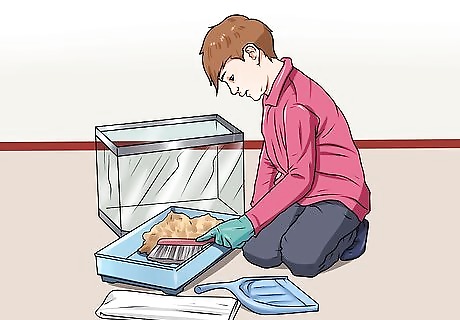
Understand the risks of a dirty cage. Cleaning your hamsters home is an important aspect of maintaining your hamsters health. Hamsters are sensitive creatures that require a clean home to stay healthy. If you neglect to clean your hamsters cage, you might be responsible for it falling ill. Avoid some of the following illness that result from a dirty cage and keep your hamster healthy: Pododermatitis affects the foot, causing raised red patches and results from extended exposure to urine and feces. Wet-tail is an illness that is caused by stress, which a dirty cage can produce in your hamster. Wet-tail is a serious disease that can kill your hamster. Your hamster may also show signs of illness if it has a runny nose, weakness, or diarrhea.



















Comments
0 comment